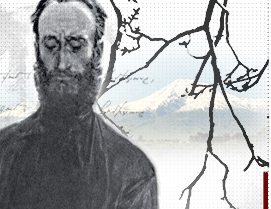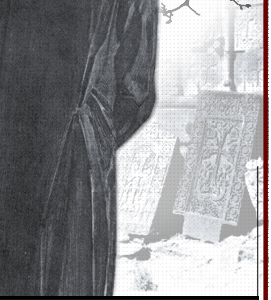ARTICLES
OF KOMITAS ABOUT FOLK MUSIC
ARMENIAN FOLK SONGS AND
CHURCH SONGS
What is national music?
What provides the subject matter for national folk songs? Could
it be the proud mountains, the deep valleys, the fields, the varied
climate, the many historical events and happenings, the internal
and external life of the people? Yes, indeed, all of these constitute
the materials for a national music, in a word, everything that affects
the feelings and the mind of that nation.
Our music is divided into two main categories: 1) liturgical,
and 2) secular, or, more appropriately, folk.
Both liturgical and secular music have the common characteristic
of one author for the tune and text, or music and poetry. They carry
the imprint of a angle person's creativity.
Let us now move to our folk songs. These songs are divided into
the following types:
Children's songs, which have the simplest form.
Dance songs, which are called yayli and are somewhat more elaborate
than the former.
Epic songs, which are dedicated to the praise of a hero.
Funeral songs dedicated to the memory of victims of accidents and disasters. This type includes tragic laments, and wailing songs
for the dead.
Wedding songs, which are sung during various wedding rituals, after
the marriage ceremony.
Songs of nature, which are the most colorful and interesting.
Some people do not understand the spiritual and musical complexities
of our music and are, therefore, only able to grasp the most superficial
aspects of the songs. Without a full knowledge of the music, they
are led to an incorrect conclusion that our folk songs and liturgical
melodies are of completely different characters.
Our folk songs and liturgical songs have not developed in equal
measure. The former have been repressed, restrained, and restricted
due to external political circumstances, without losing their depth
and their expressive force; while the latter have flourished, grown
and prospered under the inviolable protection of the church.
ARMENIAN PEASANT MUSIC
There was a time when peasant songs were considered
worthless. Even educated men of the past century wrote and declared
that Armenian peasant does not have poetry or song. This notion
soon became widespread, because the peasant himself does not think
much of his everyday compositions, which are as routine to him as
bread and water. The peasant despises most of his own song types;
he ridicules the scholars who collect and write down with care these
“hand-me-downs and effeminate ditties”.
When the folk song moved through the schools from village to town,
and established its roots there, Armenian minstrels started to play
and compose songs using folk idioms, in accordance with the style
of the time.
Armenian minstrels have a school independent and distinct from folk
songs. The minstrel schools are of two kinds. The first includes
the educated minstrels, the second the self-taught. Self-taught
musicians are the bridge between the genuine folk tradition and
the educated minstrel school. They sing in foreign or native languages.
Their renditions of foreign melodies are ungraceful and corrupt,
whereas the Armenian folk songs that they sing, though quite clean,
are full of crude, crusty, craggy, and tasteless embellishmemts.
Unfortunately, this unpleasant declamatory style is used by the
rural male also, from adolescence onward, whereas the women retain
the purely national intonation.
Educated minstrels occasionally sing folk songs, but they are more
interested in Arabic, Persian and Turkish music. They regard folk
songs merely as music for entertainment rather than for serious
performance, because they consider the songs crude, trivial, and
styleless, and inconsistent with the spirit of their school.
The educated minstrels most often sing and play using forms of Arabic,
Persian and Turkish minstrel writing, though occasionally their
texts are Armenian. Often, they adapt new words to ready-made tunes.
In such cases they use the Turkish sharki and turki melodies, because
they do not normally listen to Arabic and Persian melodies, and
the ones that they do hear are quite weighty and bardic, inappropriate
to the lyrical style.
Ask an Armenian peasant the name of the place
where a certain song originated; whether he knows it or not, he
will give you the name of a village. Ask him the name of the person
who composed the song, he will refer you to the well-known singer
of that village. When you question the singer, he will give you
the name of some other person or will shrug his shoulders. The name
of the author is known in songs which have memorable subjects, such
as the story of one mauled by a hyena, or drowned in the sea, or
asphyxiated by a blizzard, or assassinated, or of a daughter abducted,
and so on. Such songs are composed by the gousans, ordinary, wandering,
or unlettered poet singers who, after narrating the incident, give
their names in the last stanza. But in time, when the song gets
older, the author is forgotten or mistaken for another singer, because
the song itself is what interests the peasant and not the author;
the author can be this person today, another tomorrow. The talent
of composing is a natural gift for the peasant; all peasants more
or less know how to compose and sing songs. They study the art of
composition from nature, which is their unfailing school.
In the village everyone knows more or less how to sing, for they
all participate in the creation of a song. But nobody knows who
"concocted" the song, for they all take part in the creative
process. Nobody knows where it is composed, for it could have been
composed anywhere. Nobody knows how it is composed, for the creation
of song is a spontaneous activity. Nobody knows when it appeared,
for every moment brings with it a new variation.
The creation of songs for the peasant is as common as conversation.
If one does not write down what is said, or if thoughts are not
retained in our spirit, we will not remember them later. Villagers
adhere strictly to the prescribed use of the different types of
songs. Each song must be learned or sung in its proper place and
time: They will sing work songs during work, and domestic songs
while at home, and so forth. No villager will sing a threshing song
when at home, for the place to sing the threshing song is on the
threshing floor.
Each song is tied to a moment in village life and is related to
just that moment. The peasant cannot comprehend, create, or utilize
a song that is removed from that moment.
Armenian folk music is made up of solo and choral singing.
Even though Armenian popular music rejects polyphony, there are
often instances that reveal vestiges of two-part singing.
ARMENIANS HAVE A UNIQUE MUSIC
What music on earth is unmixed and pure? Only
that of animals, which vccalize the same sounds and the same intonation,
for they do not have the gift of borrowing.
The mutual influence of national styles is an undeniable phenomenon,
and there is no nation that remains isolated from such merging of
idioms. Each nation appropriates a thing it does not possess from
one that does and integrates it into its national style.
Any nation's language and literature assimilates elements of language
from other nations as it develops. But, if a nation has a unique
language and literature, it has a unique music as well.
…Poor Armenian people! A nation you are, as unique as other
nations; nobody can deny that. Yours is a distinct tongue: you speak.
You have a distinct mind: you judge. You have a distinct physionomy,
through which you are distinguished from other nations and their
physical make. But your heart, which is the source of your feelings,
is allegedly not yours, it is merely Assyro-Byzantine and Indo-Persian.
There may be one manner and there may be another. From the mouth
to the ear is a short distance; but from hunch to proof is a long
way.
ARMENIA’S NATIONAL CIRCLE DANCES
Dance is perhaps one of the most significant
manifestations of human existence. It expresses the particular traits
of a nation, especially its customs and the level of its civilization.
For through its manifold movements dance unconsciously exposes the
workings of the spirit.
The tempo of Armenian dances does not remain the same from start
to finish. They begin slowly, and gradually go to medium speed and
then to the lively, from which they slow down gradually, going from
the lively to the medium speed, to the slow.
Ethnic Armenian dances are circle dances. This type is deep-rooted
mainly among the Armenian peasants, who safeguard the old and invent
new forms; thus the national dance becomes ever richer. Here is
how the dance is organized: the dancers choose a chorus leader who
is well known as a singer and dancer. This position can be occupied
by either a young woman or a young man, while the dance group can
be mixed or of the same gender.
Ordinarily instruments are not involved in genuine Armenian folk
dancing. Even though the use of instruments has been introduced,
it is still a foreign influence. Dancing with the accompaniment
of musical instruments is done only among the urban population,
in cities and nearby towns, which have come in contact to some degree
with foreigners. The non-foreign-influenced Armenian dancing is
done only to singing.
In the vicinity of the village (rural areas) it is customary for
only unmarried and newlywed girls and men to dance. We have never
seen old people dance. However, in the cities, where the peasant
songs and dances have penetrated since 1860’s, young and old,
married and unmarried, old men and women, in a word, everybody dances.
But here the poetic content of the innocent and natural folk dance
becomes more entertainment-oriented.
The Armenians, especially those who live in the cities, also enjoy
foreign dances, European dances are, as well as those of the Caucasian
peoples. The Caucasian dances are customarily solo dances or duets;
the foreign dances are performed especially at weddings and other
festive occasions. However, they do not have the naturally naive
character of the Armenian folk dances.
DANCE AND THE CHILD
Dance is a phenomenon of quintessential
significance, for it combines all the other arts. Dance, as movement,
has a very important role in education, for all the arts –
music, sculpture, architecture, and the others – are made
of movement. There is dance in all of life. Is not the life of the
entire universe a dance? In the life of man there are two types
of dance: one is joyful, the other, sorrowful. Even though nowadays
people employ the former, in ancient times the sorrowful dances
were danced as well, as exemplified in the funereal dances of our
ancestors, which they performed during burial ceremonies expressing
physical movements commensurate to their grief. Among civilized
nations, dance, like song which developed into tragedy, has found
its culmination in opera.
The sophistication of dance is directly related to the degree of
mental sophistication of the population, and, consequently, the
development of indigenous dance is linked to the development of
a nation's civilization.
Ladies and gentlemen of the teaching profession, approach the task
of education with care and reverence. You are called upon to educate
the generation which will be tomorrow's nation. With a wrong step
you could bring harm to the nation.
|

